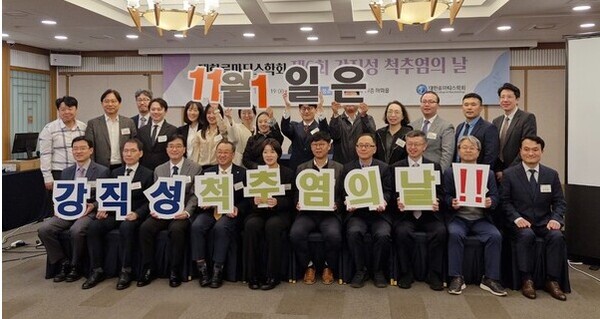“I've had spondylitis for over 30 years. I started having back pain when I graduated from high school and went to an orthopedic surgeon, but I was not diagnosed with ankylosing spondylitis until two or three years later when the disease had progressed significantly. At that time, there were injections, but I didn't have health insurance, so I had to give up treatment because it cost 1.2 to 1.3 million won per month. After the disease worsened and I was covered by health insurance in 2008, I could get intensive treatment, and now I feel much better. I wonder if I could have been diagnosed sooner and if the first place I went to in my early 20s had raised suspicions or recommended active testing. Most people with ankylosing spondylitis look fine on the outside but live with pain on the inside. They feel unhappy because they can't exercise like normal people. I think I could have lived a happier life if I had been diagnosed early and received active treatment.”
This is the story of Kim Jae-hyun, a patient who attended the “Sixth Ankylosing Spondylitis Day” ceremony held by the Korean College of Rheumatology last Friday.
Ankylosing spondylitis is a rheumatic disease in which immune cells attack and inflame the attachments between bones, such as ligaments and tendons. This gradually stiffens the vertebrae and causes systemic inflammation. It can cause serious complications in the joints and other organs, including the colon, skin, eyes, and lungs. It is especially common in young men between 20 and 40.

If diagnosed and treated early, patients can lead a normal life. However, if diagnosis and treatment are delayed, the destruction of the joints, known as osteoarthrosis, can be disabled and threaten the patient’s life.
Ankylosing spondylitis can easily be mistaken for a disk, so ‘sacroiliac joint' tests are essential
Ankylosing spondylitis is often mistaken for simple back pain. Patients wake up with stiffness and pain in their back, but it goes away when they move, so they don't think much of it. Even if an MRI scan is performed, the lesion cannot be identified unless the sacroiliac joint is imaged, so it is easy to mistake it for a herniated disk.
“There are two unfortunate cases when I see ankylosing spondylitis patients in the clinic. The first is when they don't suspect it (ankylosing spondylitis) and don't diagnose it for two to three years, 10 years, or even 20 to 30 years,” said Professor Cha Hoon-Suk of the Samsung Medical Center and president of the Korean College of Rheumatology.
Suppose patients suspect a disk, go to a spine specialty hospital instead of a rheumatology hospital, and take an MRI. In that case, radiologists don't take a picture of the sacroiliac joint, only the spine. Hence, patients often miss the inflammation of the sacroiliac joint, which is the most important part of ankylosing spondylitis. As a result, Dr. Cha added that patients go from one clinic to another.
The second is misdiagnosis, which leads to patients receiving treatment they don't need.
“Some patients have been diagnosed with ankylosing spondylitis and have undergone treatment, including biologics, but have not seen any results and only then come to the rheumatology department,” Cha said. “In such cases, they have received unnecessary and dangerous treatment due to misdiagnosis, and to prevent this, a medical environment should be established where a rheumatology specialist can diagnose patients.”
Professor Hong Seung-jae of Kyung Hee University Medical Center and director for insurance at the rheumatology society, said, “Spinal arthritis, including ankylosing spondylitis, is not easy to diagnose. Many cases of late diagnosis are due to various symptoms, including ankle pain, knee pain, ligament pain, or eye pain. As a result, there will inevitably be errors in the initial medication. Moreover, when biologics become available, some people quickly choose biologics.”
However, Dr. Hong added that there are quite a few cases where the diagnosis is incorrect, and there are many cases where it is not administered to patients who should be administered quickly.
“Patients with severe and intractable diseases need to be diagnosed by experts, a treatment plan is established based on the diagnosis, and guidelines help direct treatment,” Hong said. “In particular, experts must prescribe biologics by the required usage and dosage, which is a necessary element of health insurance coverage.”

Ankylosing spondylitis is first treated with non-steroidal anti-inflammatory drugs and antirheumatic drugs. If symptoms do not improve, biologics, including tumor necrosis factor (TNF)-alpha inhibitors, interleukin (IL)-17 inhibitors, or Janus kinase (JAK) inhibitors, are used. JAK inhibitors have received coverage for second-line treatment since late last year.
“In the past, there were only a few biologics, but recently, there are also oral medicines other than injections, so the convenience of taking them has increased,” said Professor Park Kyung-su of the Catholic University of Korea St. Vincent's Hospital, a member of the society’s public relations committee. “However, the problem is side effects and complications. The most worrying is infection. In the case of ankylosing spondylitis patients, immunosuppressive drugs relieve arthritis symptoms, but they also make patients vulnerable to infections, so patients are cautioned against the possibility.”
“There are also unexpected side effects. If the systemic inflammation persists, it doesn't just affect the joints, but also affects other parts of the body, including the hardening of the arteries, which increases the risk of angina and stroke much more than in the general population,” Professor Park said. “Therefore, it is important to reduce the inflammation early to prevent complications, and rheumatologists are the ones who can manage it.”
Related articles
- New blood biomarker predicts immunotherapy response in liver cancer patients
- Ankylosing spondylitis is an autoimmune disease harsher for men than women
- Are probiotics also suitable for people with rheumatism? No.
- 'Biportal endoscopic discectomy safer, less painful than conventional spine surgery in treating herniated discs'

